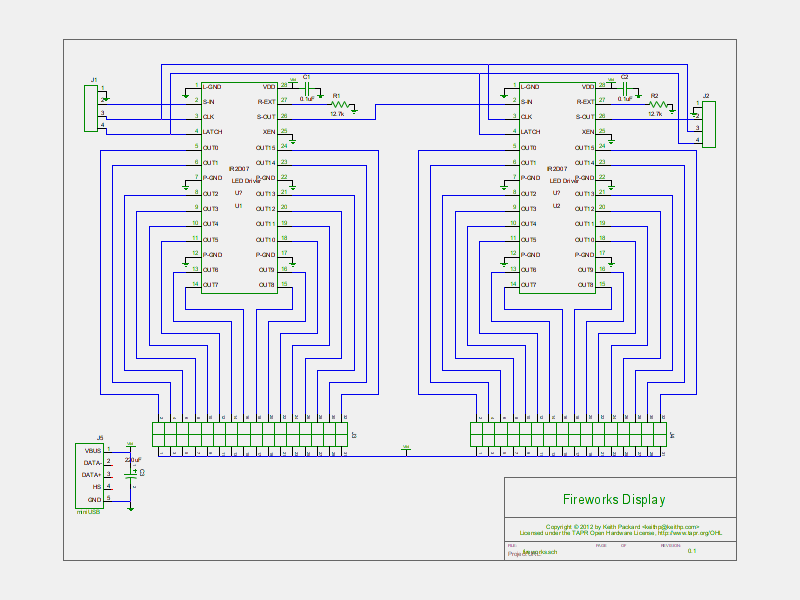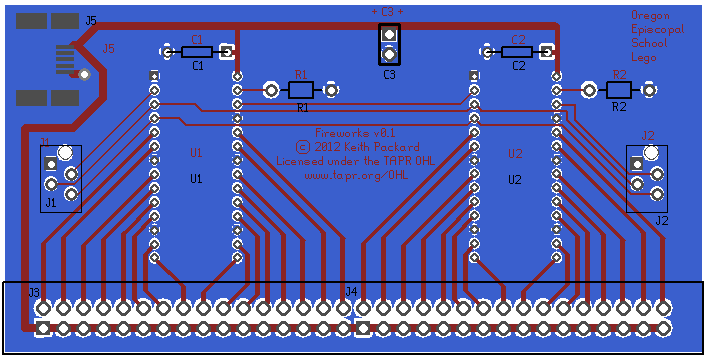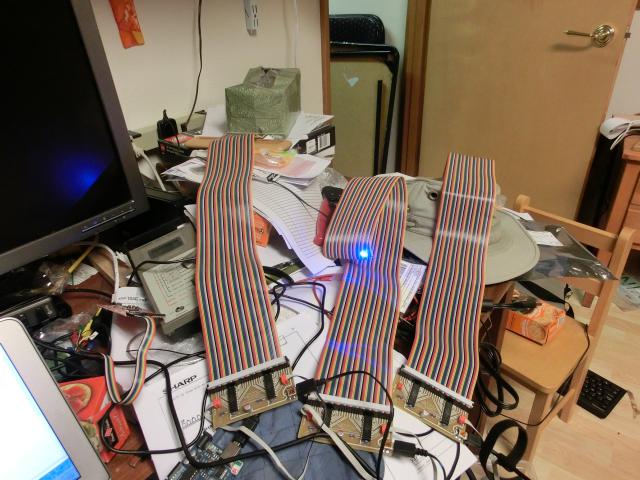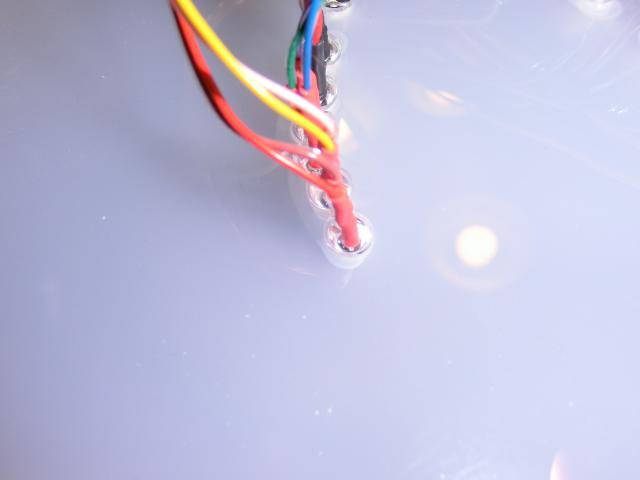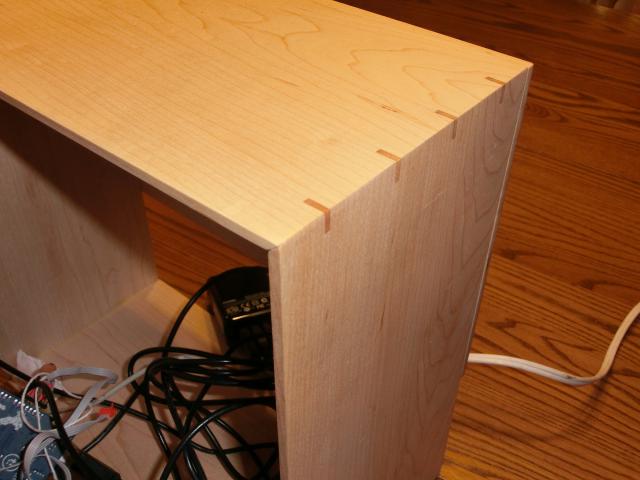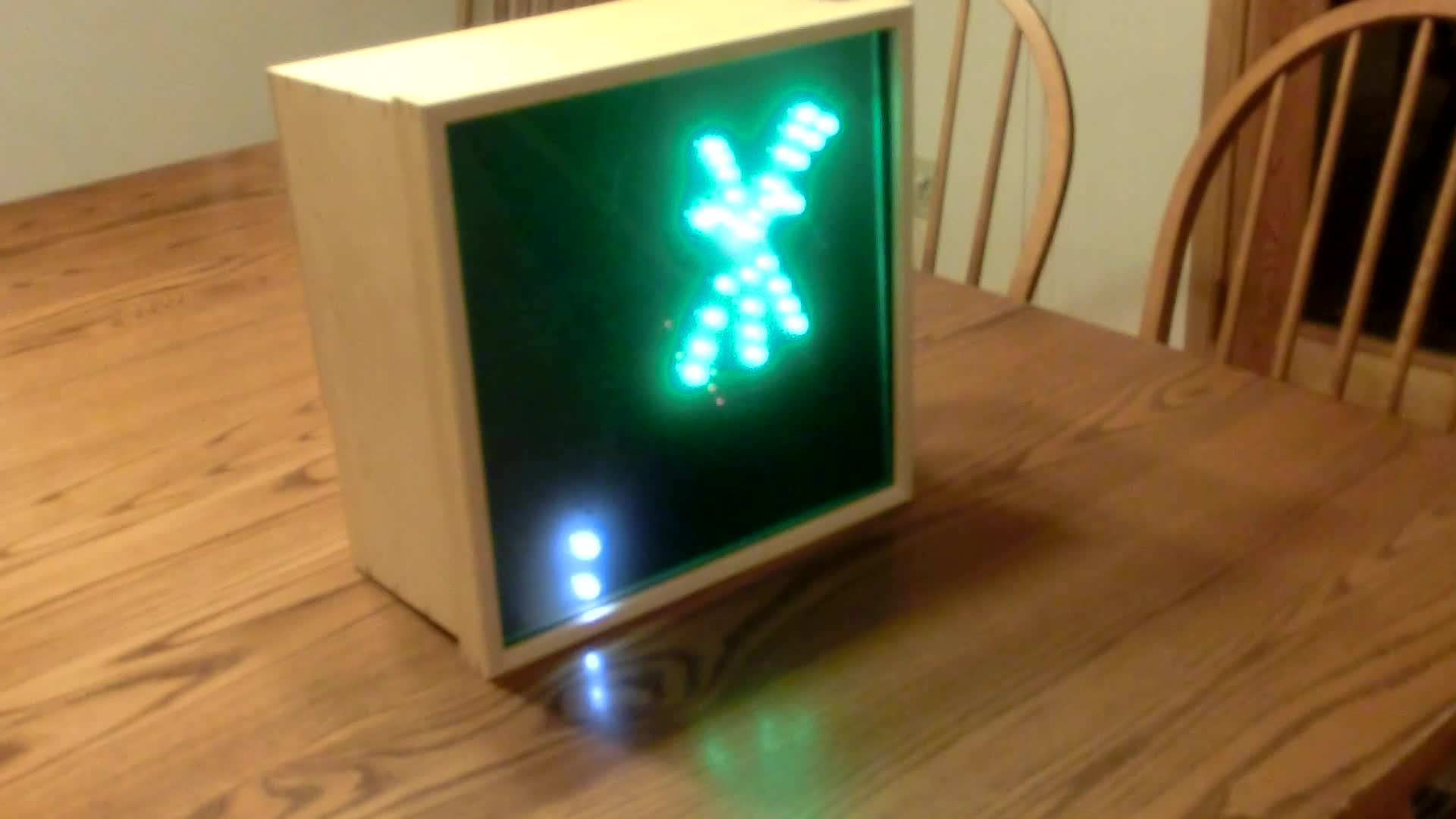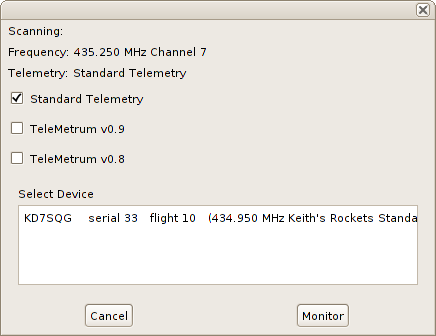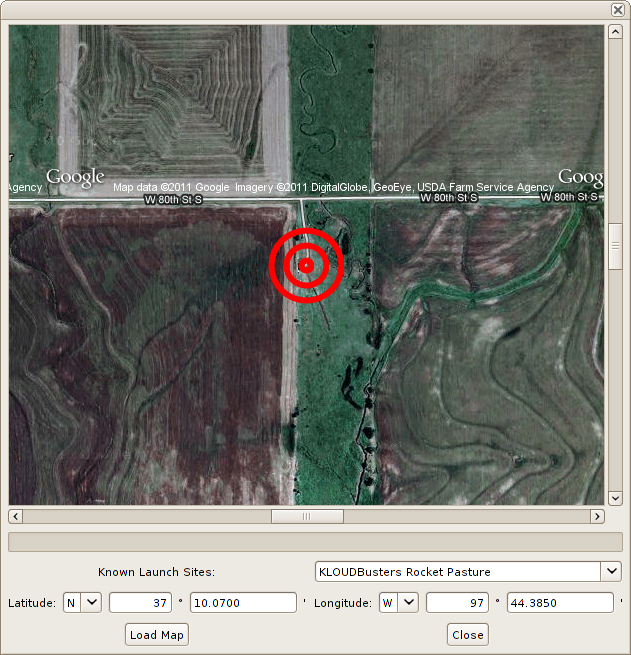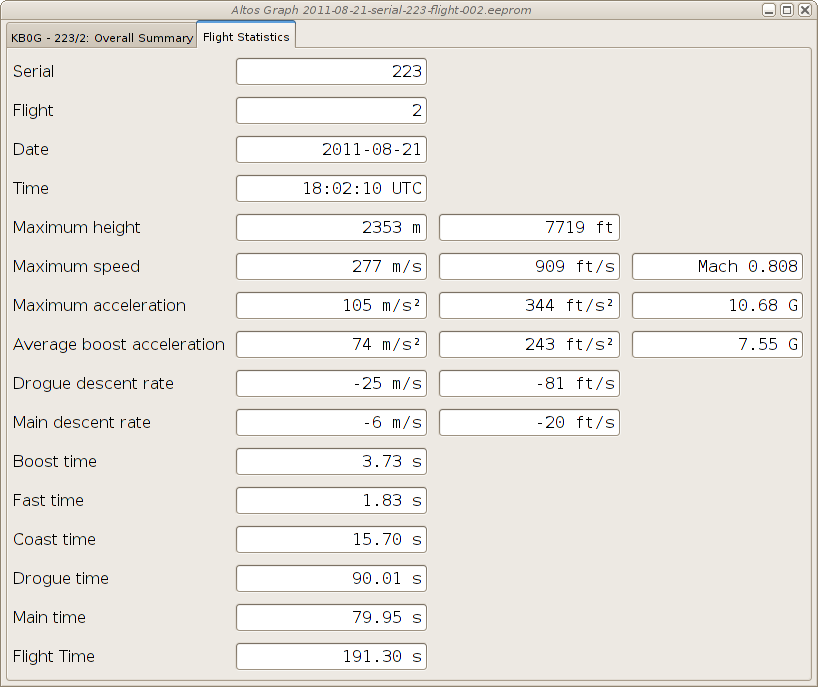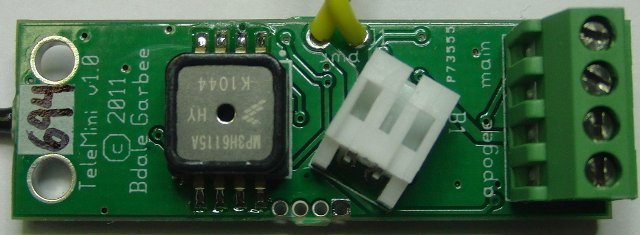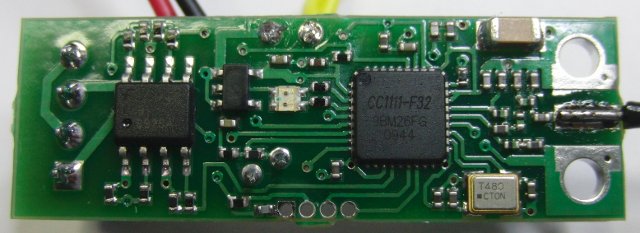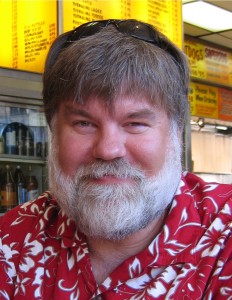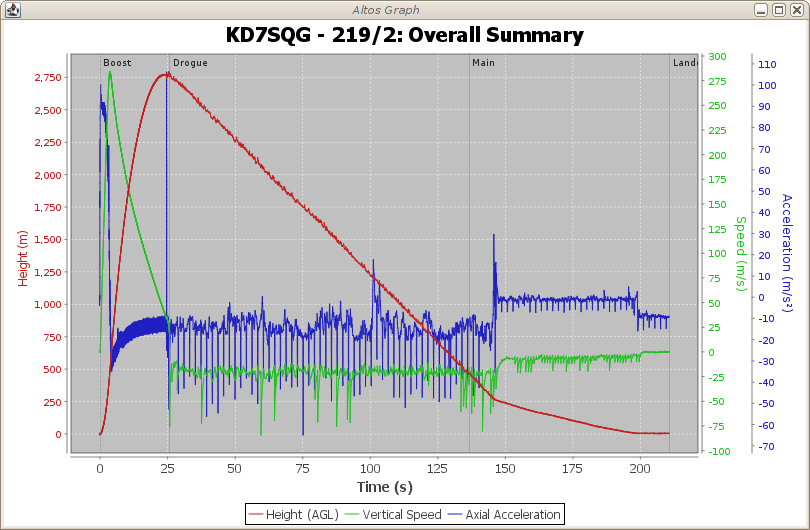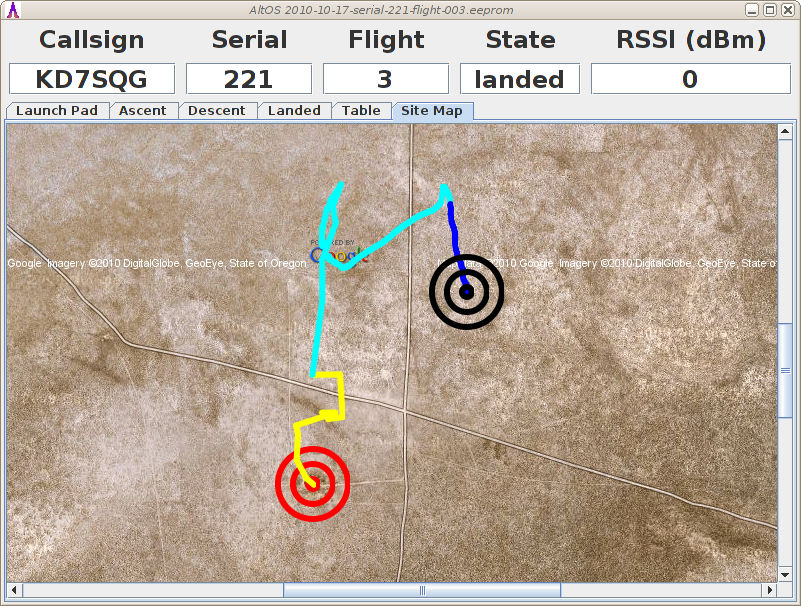
Forward Error Correction with the TI CC1120 Sub-GHz transceiver
We re building a new, fancier flight computer and decided to give the
new, fancier
TI CC1120 chip a try.
It has significantly more transmit power (+16dBm) and receive
sensitivity (-109dBm) than the transciever built in to
the
TI CC1111 RF SoC that we ve
built our other boards with. Given that we d already decided to use a
fancier
STM32L
processor, using the nicest stand-alone radio chip we could find
seemed to make good sense.
One of the nice features found in the CC1111 is support for FEC using a
1/2 rate constraint length 4 convolutional code.
Both the encoder and the
soft-decision Viterbi decoder
are built right into the chip; all we had to do was flip a couple of
bits and we got error correction, interleaving, data whitening and CRC
checking all for free.
We assumed that, as the CC1120 was advertised as a better
replacement for our CC1111 radio, that it would also include all of
these fine features. After we got the chip all soldered down to our
first prototype boards, we read through the reference manual looking
for the right register values to flip for forward error correction. We
found support for CRC computation and data whitening, but no mention
of interleaving or forward error correction at all.
Thanks, TI. Of course, without the FEC pieces, the other packet
handling hardware is worthless you can t exactly do a CRC on the
encoded data and expect it to be useful on the other end of the link,
and data whitening happens after the CRC.
Basic CC1120 driver
I assumed I d eventually figure out something to do about the FEC
pieces and started writing a basic
CC1120 driver
AltOS, the operating system used in
all of our projects. I started with the transmit side, as that seemed
easier as I could use the existing packet hardware by uploading the
desired bit sequence using whatever fancy encoding desired and the
hardware would happily transmit it.
I first tested that using low data-rate bits (2kbps), transmitting an
alternating sequence of zeros and ones to generate a 1kHz tone on a
regular 70cm receiver. That seemed to work just fine, demonstrating
that I had some grasp of the basic operation of the chip.
Convolutional Encoding in Software
Not to be daunted by a small challenge in software, I set out to
replicate the encoding scheme used in the CC1111 chips for use in our
CC1120-based design. We obviously want our CC1120 boards to
interoperate with the CC1111 boards. Fortunately, TI
fully documents
the CRC, data whitening, convolutional encoding and interleaving done
in the hardware.
I created my own implementation of the encoder (licensed, as usual, under the
GPLv2) which you can see in the file
ao_fec_tx.c
It s not quite as flexible as the hardware, it always whitens the data
and always appends the CRC bytes to the end of the packet, along with
the necessary trellis termination bytes.
The core of that code is surprisingly simple:
static const uint8_t ao_fec_encode_table[16] =
/* next 0 1 state */
0, 3, /* 000 */
1, 2, /* 001 */
3, 0, /* 010 */
2, 1, /* 011 */
3, 0, /* 100 */
2, 1, /* 101 */
0, 3, /* 110 */
1, 2 /* 111 */
;
uint8_t
ao_fec_encode(const uint8_t *in, uint8_t len, uint8_t *out)
uint8_t extra[AO_FEC_PREPARE_EXTRA];
uint8_t extra_len;
uint32_t encode, interleave;
uint8_t pair, byte, bit;
uint16_t fec = 0;
const uint8_t *whiten = ao_fec_whiten_table;
extra_len = ao_fec_prepare(in, len, extra);
for (pair = 0; pair < len + extra_len; pair += 2)
encode = 0;
for (byte = 0; byte < 2; byte++)
if (pair + byte == len)
in = extra;
fec = *in++ ^ *whiten++;
for (bit = 0; bit < 8; bit++)
encode = encode << 2 ao_fec_encode_table[fec >> 7];
fec = (fec << 1) & 0x7ff;
interleave = 0;
for (bit = 0; bit < 4 * 4; bit++)
uint8_t byte_shift = (bit & 0x3) << 3;
uint8_t bit_shift = (bit & 0xc) >> 1;
interleave = (interleave << 2) ((encode >> (byte_shift + bit_shift)) & 0x3);
*out++ = interleave >> 24;
*out++ = interleave >> 16;
*out++ = interleave >> 8;
*out++ = interleave >> 0;
return (len + extra_len) * 2;
ao_fec_encode_table takes care of the convolutional piece,
ao_fec_whiten_table (not shown) contains the data whitening codes
while the little loop at the bottom does the interleaving. I didn t
spend a lot of time optimizing this as it seemed to run plenty fast on
the 32MHz processor.
With the bits all nicely encoded, I passed them to my simple CC1120
driver and let it send them along to our CC1111 receiver. Much to my
delight, with only a few bugs fixed, it worked just fine! I d managed
to get one direction working, validating the hardware and making it
clear that we d at least be able to use the board in flight for
telemetry.
Getting Soft-decision data out of the CC1120
In packet mode, the CC1120 receiver converts the incoming GFSK stream
directly into bits, making its best guess as to whether the detected
value was a one or zero. Of course, like any FM modulation, the
receiver will be producing intermediate values, especially when the
signal is weak or masked by interference. A Viterbi decoder can make
good use of this information;these noisy intermediate values are less
influential in the final resulting path cost which allows the strong
0/1 values to pull the solution to the right one. Soft decision
decoding yields a theoretical 2dB gain over hard decision decoders,
and given our desire for maximum packet reception over long distances,
it seemed important to make this work.
The CC1120 has a way to recover the soft decision values, but only one
8-bit value at a time. It does, however, helpfully provide a GPIO
wire which can be programmed to interrupt the CPU when the soft
decision data has arrived.
So, I hooked up a GPIO line on the processor to the GPIO line on the
CC1120 and let it interrupt once per bit time, or 38400 times
per second, to read this valuable soft decision data out of the radio
part. According to TI support, this is the only way to make this work,
and that they generally recommend that developers use the packet mode
stuff and throw away this valueable source of data.
I was happily surprised to learn that the STM32L can in fact survive
this interrupt rate, and by setting interrupt priorities
appropriately, I manage to reliably capture an entire packets worth of
data without dropping a single bit.
I set up a simple packet dumping function to run on the prototype
board and captured raw encoded bytes from our CC1111-based flight
computer so that I d have some real data to work from.
Soft-decision Viterbi Decoding
The sample encoding implementation from TI made that piece fairly
straightforward. Lacking a similar sample for the decoding piece meant
that I d be starting from scratch. And, implementing something that
seemed like magic to me when I started. I started by reading a few
articles on Viterbi decoding:
I found
Chip Fleming s tutorial
very useful as it included a bunch of worked examples using a
convolutional encoders with constraint length (k) of 3 instead of 4;
this makes all of the trellis diagrams half the size.
I also sent my friend,
Phil Karn, a query about
this process, and he responded with a bunch of helpful suggestions,
while also recommending that I just steal his
DSP and FEC library
implementation. Of course, I don t like using code that I can t
understand, and his code only implements much longer codes than I
needed, so I d have to understand it anyways to make it work for
me. Phil s code is a marvel, but it s not exactly comprehensible to
someone who doesn t even know what a Viterbi decoder is supposed to do.
So, with Chip s tutorial on my screen, I wrote a primitive Viterbi
decoder. This did only the Viterbi step, and split that into two
phases. The first computed the cost for each state in the system for
every received pair of symbols received. It also tracked the chain of
states through the entire decode process:
for (state = 0; state < 8; state++)
struct ao_soft_sym zero = ao_soft_sym(ao_fec_encode_table[state * 2 + 0]);
struct ao_soft_sym one = ao_soft_sym(ao_fec_encode_table[state * 2 + 1]);
uint8_t zero_state = ao_next_state(state, 0);
uint8_t one_state = ao_next_state(state, 1);
int zero_cost = ao_cost(s, zero);
int one_cost = ao_cost(s, one);
zero_cost += cost[b][state];
one_cost += cost[b][state];
if (zero_cost < cost[b+1][zero_state])
prev[b+1][zero_state] = state;
cost[b+1][zero_state] = zero_cost;
if (one_cost < cost[b+1][one_state])
prev[b+1][one_state] = state;
cost[b+1][one_state] = one_cost;
At the end of the packet, it found the least costly path and walked
that from back to front, generating output bits (yes, one bit per
element of the bits array):
for (state = 1; state < 8; state++)
if (cost[b][state] < c)
c = cost[b][state];
min_state = state;
for (b = len/2; b > 0; b--)
bits[b-1] = min_state & 1;
min_state = prev[b][min_state];
Completely separate from this code were the interleaving and data
whitening stages. Keeping those separate allowed them to be tested
independently, which made debugging them far easier.
None of this code ever ran on the STM32L processor, it was instead run
in a test framework on my laptop. I first got this working with data
generated by the software convolutional encoder, then I managed to get
it to decode the raw packets that I had recorded directly from the
receiver it self.
This marked a significant milestone in my mind I d managed to
replace, in software, the CC1111 FEC encoder and decoder. However, the
decoder performance was not fast enough to manage back-to-back packets
yet. Having something in hand that worked meant that further
development would be directly comparable to something that did work,
making optimization much easier. Yet another lesson in making it work,
and
then making it work fast.
Optimizing the Viterbi Decoder
The first step was to reduce memory usage within the decoder. While
it s best to defer computing the path until the very last bit has been
received, it s also true that the chances of a bit affecting old data
reduces as the distance between the new and old data increases. With
the rule of thumb being a distance of k 6 or k 7, I saved 32 output
bits for each state and wrote the oldest of 8 each time the buffer
filled up, making a distance of 24 bits between the newest saved data
and the current decoding position. That meant a fixed amount of
storage was needed for an arbitrarily long packet.
I tested a variety of different history sizes from 8 to 56 bits
(cooresponding to 16, 32 and 64 bits of saved data for each
state). With 100000 random packets generated that had gaussian noise
added to each bit, here are the error rates for the different history lengths:
| History Length | Total Packets | Correct | Incorrect |
| 8 bits | 100000 | 90520 (90.52%) | 9480 (9.48%) |
| 24 bits | 100000 | 93614 (93.61%) | 6386 (6.39%) |
| 56 bits | 100000 | 93620 (93.62%) | 6380 (6.38%) |
The performance of the 8-bit history and 16-bit history versions
turned out to be essentially identical (given the 32-bit nature of the
STM32L, that shouldn t be too surprising). The performance of the
56-bit version, which manipulated uint64_t data types was sigificantly
slower, and given the very modest benefit, deemed not worth it. If we
move to a larger constraint length (k > 4), or started using a
punctured convolutional encoding, we would want to re-measure this.
The next step was to combine the de-interleaving, decoding,
de-whitening and CRC computation into a single loop. This would
eliminate a pile of data copying and extra memory usage. Nothing fancy
here, but it made enough of a difference that I could decode most of
the incoming packets now, dropping only about 25% of them.
To get to being able to decode every packet, I needed to start
decoding the packet while it was being received. Because of
interleaving, I had to have 32 bits of data to be able to decode
anything, so it was a simple matter of having my per-soft-value
interrupt handler start the decoder going after each interleave block
of data was received. With this in place, I was able to decode a
76-byte payload (160 transmitted bits) in 14.7 ms, or just about 50%
of the time it took to transmit the packet. Unrolling one of the inner
decoding loops eliminated a bunch of computation and sped this up even
more, decoding packets in 9.5ms.
Success at last, a solid 100% of packets received were being decoded,
as long as the CPU was otherwise idle.
Finally, I went and re-read Phil Karn s code and pondered over how it
works. It was opaque until I wrote a message back to Phil asking how
it worked and pointing out sections that were confusing. Fortunately,
simply phrasing my confusion in words made me understand how the code
works. Here s my original code for computing the per-state cost
metric:
/* Metric for a zero bit */
uint32_t bitcost = ((uint32_t) (s0 ^ ao_fec_decode_table[(state<<1)]) +
(uint32_t) (s1 ^ ao_fec_decode_table[(state<<1)+1]));
/* Total path metric and state for a zero bit */
uint32_t cost0 = cost[p][state] + bitcost;
uint8_t state0 = ao_next_state(state, 0);
/* Compare the total path metric against all existing
* metrics heading into the same new state, choosing
* the least expensive and killing the others. Record
* the new lowest cost and output bit.
*/
if (cost0 < cost[n][state0])
cost[n][state0] = cost0;
bits[n][state0] = (bits[p][state] << 1) (state & 1);
/* Total path metric and state for a one bit. Because
* encoding a one is always exactly the opposite of
* encoding a zero from any state, this cost is
* 255*2 - bitcost
*/
uint32_t cost1 = cost[p][state] + 510 - bitcost;
uint8_t state1 = ao_next_state(state, 1);
if (cost1 < cost[n][state1])
cost[n][state1] = cost1;
bits[n][state1] = (bits[p][state] << 1) (state & 1);
Before this loop is run, I have to initialize cost[n] to a large
value so that the comparisons will be true for the first case to reach
each state. Phil s code, in contrast, doesn t have to initialize
cost[n] as we
know which two states can reach any possible new
state. His code looks like this:
/* Metric for a zero bit */
bitcost = ((uint32_t) (s0 ^ ao_fec_decode_table[(state<<1)]) +
(uint32_t) (s1 ^ ao_fec_decode_table[(state<<1) 1]));
/* Only state and state+4 reach state<<1 with a zero bit */
/* Cost from state to state<<1 for a zero bit*/
m0 = cost[p][state] + bitcost;
/* Cost from state+4 to state<<1 for a zero bit */
m1 = cost[p][state+4] + (510 - bitcost);
/* Which source state is cheaper? */
bit = m0 > m1;
/* Record the cheaper cost and the add to the path of bits */
cost[n][state<<1] = bit ? m1 : m0;
bits[n][state<<1] = (bits[p][state + (bit<<2)] << 1) (state&1);
/* State and state+4 reach (state<<1)+1 with a one bit */
/* Cost from state to (state<<1)+1 for a one bit */
m0 -= (bitcost+bitcost-510);
/* Cost from state+4 to (state<<1)+1 for a one bit */
m1 += (bitcost+bitcost-510);
/* Which source state is cheaper? */
bit = m0 > m1;
/* Record cheaper cost and add to the path of bits */
cost[n][(state<<1)+1] = bit ? m1 : m0;
bits[n][(state<<1)+1] = (bits[p][state + (bit<<2)] << 1) (state&1);
This code does two states at a time, and so while it s slightly longer
than the above, it only needs to run half as many times. The resulting
code now decodes packets in 5.7ms.
The final version of the code can be see in
ao_fec_rx.c
The whole AltOS operating system, with many drivers and support for
CC1111, AVR and STM32L processirs is available, under the GPLv2 from
git://git.gag.com/scm/git/fw/altos
 I am pleased to announce that HP accepted my application for participation
in this year's Enhanced Early Retirement program. After 26.5 years, my last
day at HP will be 31 August 2012.
This isn't because I have a problem with HP, quite the contrary! I feel
immensely privileged to have worked on so many interesting things with so
many smart people for so long. And there are many exciting things happening
right now, including high profile projects like
Odyssey and Moonshot
expanding both ends of the server scaling continuum with Linux, and the
immense commitment to and investment in Open Source represented by the
use of Open Stack and Ubuntu LTS
in building HP Cloud. The temptation to stay and
continue to help guide HP's Open Source engagement
was strong. I'm certainly under no pressure to leave... in fact, I think I
managed to shock my management with my decision to retire!
But I'm very excited about "taking a break" from full-time employment for a
while to focus more time on things that matter a lot to me. My son and I
have a number of projects we'd like to work on together as he enters high
school. The side business I started two years ago with
Keith Packard to design, build, and sell
avionics solutions for high power model rockets
is growing and could use more attention. I'm in the midst of designing the
processor board for another
amateur radio satellite. And
of course, I'm looking forward to putting more "quality time" towards
Free Software projects like FreedomBox
and Debian!
Since they do not depend on my employment status, I do not expect any
immediate changes in the various roles I play outside of HP. I will continue
to serve on the board of the Linux Foundation
representing individual affiliates, on the board of the
FreedomBox Foundation, as Chairman
of the Debian Technical Committee,
and as President of Software in the Public Interest. And
while I hope to travel less than I have in recent years, I look forward to
continuing to speak and otherwise participate in key Free Software conferences
around the world from time to time.
After I retire, the primary point of contact with HP on Open Source matters
will be the Director of HP's Open Source Program Office,
Phil Robb. But if there are open issues regarding
HP and Open Source that I can help with over the next month, feel free to
contact me and I'll see what I can do to help.
I am pleased to announce that HP accepted my application for participation
in this year's Enhanced Early Retirement program. After 26.5 years, my last
day at HP will be 31 August 2012.
This isn't because I have a problem with HP, quite the contrary! I feel
immensely privileged to have worked on so many interesting things with so
many smart people for so long. And there are many exciting things happening
right now, including high profile projects like
Odyssey and Moonshot
expanding both ends of the server scaling continuum with Linux, and the
immense commitment to and investment in Open Source represented by the
use of Open Stack and Ubuntu LTS
in building HP Cloud. The temptation to stay and
continue to help guide HP's Open Source engagement
was strong. I'm certainly under no pressure to leave... in fact, I think I
managed to shock my management with my decision to retire!
But I'm very excited about "taking a break" from full-time employment for a
while to focus more time on things that matter a lot to me. My son and I
have a number of projects we'd like to work on together as he enters high
school. The side business I started two years ago with
Keith Packard to design, build, and sell
avionics solutions for high power model rockets
is growing and could use more attention. I'm in the midst of designing the
processor board for another
amateur radio satellite. And
of course, I'm looking forward to putting more "quality time" towards
Free Software projects like FreedomBox
and Debian!
Since they do not depend on my employment status, I do not expect any
immediate changes in the various roles I play outside of HP. I will continue
to serve on the board of the Linux Foundation
representing individual affiliates, on the board of the
FreedomBox Foundation, as Chairman
of the Debian Technical Committee,
and as President of Software in the Public Interest. And
while I hope to travel less than I have in recent years, I look forward to
continuing to speak and otherwise participate in key Free Software conferences
around the world from time to time.
After I retire, the primary point of contact with HP on Open Source matters
will be the Director of HP's Open Source Program Office,
Phil Robb. But if there are open issues regarding
HP and Open Source that I can help with over the next month, feel free to
contact me and I'll see what I can do to help.
 Playing around with LLC controls on Sandybridge today.
What I wanted to know was how caching backbuffers affects application
performance. The reason for this question is that when the driver uses
page flipping to display a new frame, we force the new scanout buffer
to be uncached because the display hardware only scans out from main
memory. However, when we go back to using this buffer as the next
back-buffer, we don t turn the caching bits back on as that requires
writing GTT entries to change caching modes.
This means that swapping via page-flipping and swapping via copying
has a large change in main memory access patterns during rendering
page flipping applications use an uncached back buffer while copying
applications use a cached back buffer.
What effect does the back-buffer caching-mode have on application
performance?
The changes
In the kernel, I have three modes
1) Existing code. Set buffer objects to cache mode none when
preparing them as scanout buffers. The first time the application
flips to a back buffer, caching is disabled on that buffer forever
2) Flip back and forth. Set buffers to cache mode none when used
as scanout. When that stops, flip them back to cache mode llc.
This involves a whole lot of clflushing and GTT rewriting, obviously.
3) Flush to memory, but don t disable caching. In this mode, the
buffer gets flushed (from both CPU and GPU) before being used as a
scanout, but the cache mode isn t changed.
Benchmarking with glxgears
The first test was pretty simple I hacked up glxgears (yes,
glxgears is not a benchmark) to redraw the same frame multiple times
(including the clear) per swap to provide a scalable amount of
work per swap. No pixel operations, so this is just writing to the
back buffer. Thes numbers are the median of 5 runs, except for those
obviously limited by the refresh rate.
Playing around with LLC controls on Sandybridge today.
What I wanted to know was how caching backbuffers affects application
performance. The reason for this question is that when the driver uses
page flipping to display a new frame, we force the new scanout buffer
to be uncached because the display hardware only scans out from main
memory. However, when we go back to using this buffer as the next
back-buffer, we don t turn the caching bits back on as that requires
writing GTT entries to change caching modes.
This means that swapping via page-flipping and swapping via copying
has a large change in main memory access patterns during rendering
page flipping applications use an uncached back buffer while copying
applications use a cached back buffer.
What effect does the back-buffer caching-mode have on application
performance?
The changes
In the kernel, I have three modes
1) Existing code. Set buffer objects to cache mode none when
preparing them as scanout buffers. The first time the application
flips to a back buffer, caching is disabled on that buffer forever
2) Flip back and forth. Set buffers to cache mode none when used
as scanout. When that stops, flip them back to cache mode llc.
This involves a whole lot of clflushing and GTT rewriting, obviously.
3) Flush to memory, but don t disable caching. In this mode, the
buffer gets flushed (from both CPU and GPU) before being used as a
scanout, but the cache mode isn t changed.
Benchmarking with glxgears
The first test was pretty simple I hacked up glxgears (yes,
glxgears is not a benchmark) to redraw the same frame multiple times
(including the clear) per swap to provide a scalable amount of
work per swap. No pixel operations, so this is just writing to the
back buffer. Thes numbers are the median of 5 runs, except for those
obviously limited by the refresh rate.
 You can see the LED driver chip sitting on a set of extension leads
plugged into the breadboard. It s hooked to the SPI port on the
Arduino board, with the clock set as fast as it will go. If you
watch the video, you can see that the LEDs actually vary in
brightness. They re actually being pulse-width modulated. Clocked at
2MHz, there s enough bandwidth in the SPI bus to drive 160 LEDs with
127 discrete pulse widths at nearly 100Hz (100 * 127 * 160 = 2032000).
Is bread boarding practical?
With the chip propped up on its extension wires, and the LEDs plugged
in, the whole setup was not surprisingly fragile. Getting five
of these chips wired up and running for the length of the Lego show
(one day at school and two days at the zoo) seemed unlikely. So, we
decided to build some custom circuit boards.
Using the GEDA tools to make circuit boards
My business partner, Bdale Garbee, and I build rocketry electronics
through
You can see the LED driver chip sitting on a set of extension leads
plugged into the breadboard. It s hooked to the SPI port on the
Arduino board, with the clock set as fast as it will go. If you
watch the video, you can see that the LEDs actually vary in
brightness. They re actually being pulse-width modulated. Clocked at
2MHz, there s enough bandwidth in the SPI bus to drive 160 LEDs with
127 discrete pulse widths at nearly 100Hz (100 * 127 * 160 = 2032000).
Is bread boarding practical?
With the chip propped up on its extension wires, and the LEDs plugged
in, the whole setup was not surprisingly fragile. Getting five
of these chips wired up and running for the length of the Lego show
(one day at school and two days at the zoo) seemed unlikely. So, we
decided to build some custom circuit boards.
Using the GEDA tools to make circuit boards
My business partner, Bdale Garbee, and I build rocketry electronics
through 